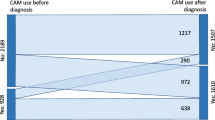Abstract
Complementary and alternative medicine (CAM) is used widely among cancer patients. Beside the risk of interaction with cancer therapies, interactions with treatment for comorbidities are an underestimated problem. The aim of this study was to assess prevalence of interactions between CAM and drugs for comorbidities from a large CAM usage survey on melanoma patients and to classify herb–drug interactions with regard to their potential to harm. Consecutive melanoma outpatients of seven skin cancer centers were asked to complete a standardized CAM questionnaire including questions to their CAM use and their taken medication for comorbidities and cancer. Each combination of conventional drugs and complementary substances was evaluated for their potential of interaction. 1089 questionnaires were eligible for evaluation. From these, 61.6 % of patients reported taking drugs regularly from which 34.4 % used biological-based CAM methods. Risk evaluation for interaction was possible for 180 CAM users who listed the names or substances they took for comorbidities. From those patients, we found 37.2 % at risk of interaction of their co-consumption of conventional and complementary drugs. Almost all patients using Chinese herbs were at risk (88.6 %). With a high rate of CAM usage at risk of interactions between CAM drugs and drugs taken for comorbidities, implementation of a regular assessment of CAM usage and drugs for comorbidities is mandatory in cancer care.
Similar content being viewed by others
References
Molassiotis A, Fernadez-Ortega P, Pud D, et al. Use of complementary and alternative medicine in cancer patients: a European survey. Ann Oncol. 2005;16:655–63.
Horneber M, Bueschel G, Dennert G, et al. How many cancer patients use complementary and alternative medicine: a systematic review and metaanalysis. Integr Cancer Ther. 2012;11(3):187–203.
Micke O, Bruns F, Glatzel M, et al. Predictive factors for the use of complementary and alternative medicine (CAM) in radiation oncology. Eur J Integr Med. 2009;1:22–30.
Huebner J, Muenstedt K, Prott FJ, et al. Online survey of patients with breast cancer on complementary and alternative medicine. Breast Care. 2014;9(1):60–3.
Ott IM, Muenstedt K, Micke O, et al. Attitude of oncology/haematology nurses from German speaking countries towards complementary and alternative medicine. Trace Elements Electrolyt. 2015;32(2):74–80.
Conrad C, Muenstedt K, Micke O, et al. Survey of members of the German Society for Palliative Medicine regarding their attitudes towards complementary and alternative medicine for cancer patients. J Cancer Res Clin Oncol. 2014;140(7):1229–37.
Trimborn A, Senf B, Muenstedt K, Buentze l, et al. Attitude of employees of a university clinic to complementary and alternative medicine in oncology. Ann Oncol. 2013;24(10):2641–5.
Huebner J, Micke O, Muecke R, et al. User rate of complementary and alternative medicine (CAM) of patients visiting a counseling facility for CAM of a German comprehensive cancer center. Anticancer Res. 2014;34:943–8.
Paul M, Davey B, Senf B, et al. Patients with advanced cancer and their usage of complementary and alternative medicine. J Cancer Res Clin Oncol. 2013;130(9):1515–22.
Henf A, Wesselmann S, Huthmann D, et al. Complementary and alternative medicine in German cancer centers. Oncol Res Treat. 2014;37:390–4.
Zeller T, Muenstedt K, Stoll C, et al. Potential interactions of complementary and alternative medicine with cancer therapy in outpatients with gynecological cancer in a comprehensive cancer center. J Cancer Res Clin Oncol. 2013;139:357–65.
Bunchorntavakul C, Reddy KR. Review article: herbal and dietary supplement hepatotoxicity. Aliment Pharmacol Ther. 2013;37(1):3–17.
Grubbs V, Plantinga LC, Tuot DS, Hedgeman E, Saran R, Saydah S, Rolka D, Powe NR. Americans’ use of dietary supplements that are potentially harmful in CKD. Am J Kidney Dis. 2013;61(5):739–47.
Loquai C, Dechent D, Garzarolli M et al. Use of Complementary and alternative medicine by patients with melanoma: a multicenter cross-sectional study in Germany (submitted).
https://www.nlm.nih.gov/medlineplus/druginfo/herb_All.html). Last Accessed 31 Jan 2016
https://nccih.nih.gov/health/. Last Accessed 31 Jan 2016
https://www.mskcc.org/cancer-care/treatments/symptom-management/integrative-medicine/herbs. Last Accessed 31 Jan 2016
Cassileth BR, Lucarelli CD. Herb-Drug Interactions in Oncology; London 2003
Robinson A, McGrail MR. Disclosure of CAM use to medical practitioners: a review of qualitative and quantitative studies. Complement Ther Med. 2004;12(2-3):90–8.
Saxe GA, Madlensky L, Kealey S, et al. Disclosure to physicians of CAM use by breast cancer patients: findings from the women‘s healthy eating and living study. Integr Cancer Ther. 2008;7(3):122–7.
Elsner T, Muecke R, Micke O, et al. Survey on the worldwide chronic myeloid leukemia advocates network regarding complementary and alternative medicine. J Cancer Res Clin Oncol. 2013;139(6):1025–31.
Author information
Authors and Affiliations
Corresponding author
Ethics declarations
Conflict of interest
The authors declare no conflict of interest.
Ethical approval
The study has been approved by the Ethic Committee of the Statutory Physician Board of Rhineland-Palatinate, Germany.
Informed consent
Informed consent was obtained from all individual participants included in the study.
Rights and permissions
About this article
Cite this article
Loquai, C., Dechent, D., Garzarolli, M. et al. Risk of interactions between complementary and alternative medicine and medication for comorbidities in patients with melanoma. Med Oncol 33, 52 (2016). https://doi.org/10.1007/s12032-016-0764-6
Received:
Accepted:
Published:
DOI: https://doi.org/10.1007/s12032-016-0764-6




